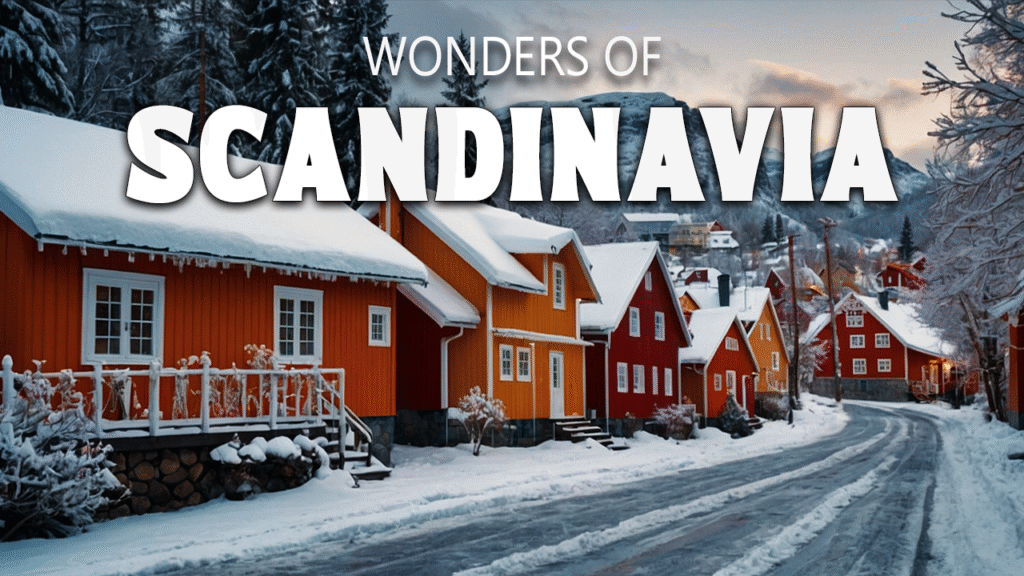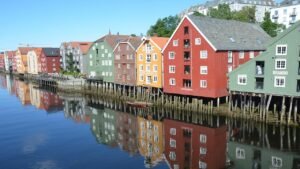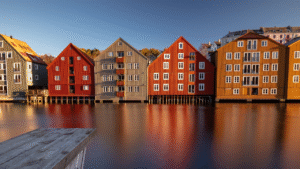Discover the enchanting wonders of Scandinavia through a comprehensive tour of Norway, Sweden, and Denmark’s most breathtaking landscapes and cultural treasures. From majestic fjords and Arctic wilderness to vibrant cities and medieval castles, this northern paradise offers unforgettable experiences for every kind of traveler.
In my journey across Scandinavia, I’ve captured the raw beauty and timeless charm that makes this region truly special, highlighting both famous landmarks and hidden gems.
Watch my full exploration of Scandinavia’s natural and cultural wonders in this travel documentary:
The Magic of Scandinavia: An Overview
Swedish Nobel Prize winner Doug Hamers Shield once said, “Whoever is born in Scandinavia has won first prize in the lottery of life.” After traveling extensively through this region, I can confirm this sentiment rings absolutely true. Scandinavia technically refers to Norway, Sweden, and Denmark, though it’s often grouped with Finland and Iceland as part of the broader Nordic region.
What makes these countries so special? Well, it’s a perfect blend of breathtaking landscapes, high quality of life, rich cultural heritage, and forward-thinking societies. Known as the land of Vikings, Scandinavia boasts majestic mountains, dramatic fjords, tranquil Arctic wilderness, and towering glaciers alongside architectural marvels and vibrant cities.
Norway’s Natural Wonders
Lofoten Islands: Arctic Beauty
My journey began in the Lofoten Islands, Norway’s dramatic gem where nature’s artistry meets centuries-old traditions. The islands feature towering peaks rising from the Arctic Sea and fishing villages painted in red and white, all bathed in the magical Midnight Sun during summer months.
One of my favorite experiences was hiking Reinebringen, which offers panoramic views over the village of Reine and surrounding fjords. It’s challenging but absolutely worth it for the breathtaking vistas of the archipelago. I also explored Henningsvær, often called “the Venice of Lofoten,” with its colorful houses built on tiny islands connected by bridges.
In Nusfjord, one of Norway’s oldest and best-preserved fishing villages, I learned about traditional fishing methods while soaking in the village’s authentic charm. The crystal-clear waters, striking mountains, and rich fishing heritage make the Lofoten Islands a photographer’s dream and an adventurer’s paradise.
Geiranger Fjord: UNESCO World Heritage
Traveling south, I reached another of Norway’s treasures – Geiranger Fjord. This UNESCO World Heritage site features towering cliffs, deep blue waters, and majestic waterfalls that left me speechless.
The first sight that welcomed me was the stunning Seven Sisters waterfall, a set of seven cascading falls plunging from dizzying heights into the fjord. For the best views, I hiked to the Dalsnibba Mountain Plateau, which rewards visitors with sweeping panoramas of the fjord and surrounding peaks.
Taking a boat cruise along Geiranger Fjord allowed me to get up close to the towering cliffs and famous waterfalls, including Suitor and Bridal Veil. The scale and majesty of Norwegian fjords truly must be seen to be believed.
Svalbard: Arctic Wilderness
Located halfway between mainland Norway and the North Pole, Svalbard offered me an experience of raw, untamed Arctic wilderness. This remote archipelago is home to vast glaciers, snow-covered mountains, and the famous polar bears – spotting one in the wild was truly a once-in-a-lifetime moment.
I took a boat tour through Isfjorden, passing towering icebergs and dramatic cliffs rising from Arctic waters. Svalbard also serves as a hub for Arctic research, with scientists from around the world studying climate change in this fragile environment.
The Svalbard Global Seed Vault, built deep into a mountain, preserves seeds from across the planet to safeguard against biodiversity loss. In Svalbard, I witnessed both the raw beauty of the Arctic and humankind’s efforts to protect our planet’s future.
Sweden’s Unique Attractions
Ice Hotel, Jukkasjärvi: A Frozen Marvel
In Swedish Lapland, I discovered a truly unique accommodation experience – the world-famous Ice Hotel in Jukkasjärvi. This marvel of innovation, culture, and sustainability is rebuilt each winter using ice blocks from the Torne River.
Artists from around the world transform ice into intricate sculptures, walls, and furniture, creating a living gallery of ice art. I spent a night in a room carved entirely from ice, sleeping on an ice bed softened by reindeer skins and thermal sleeping bags to stay warm.
What makes the Ice Hotel remarkable is its life cycle – each spring as the ice melts, the water flows back to the Torne River, leaving no trace behind. Beyond its walls, I experienced Sami cultural traditions, explored the pristine Arctic wilderness, and marveled at the Northern Lights dancing above the frozen landscape.
Kiruna: Life Above the Arctic Circle
Sweden’s northernmost town, Kiruna, offered me a front-row seat to nature’s most extraordinary spectacles. Nestled within the Arctic Circle, Kiruna experiences the Midnight Sun in summer and the magical dance of the Aurora Borealis in winter.
I learned about the rich heritage of the indigenous Sami people, including reindeer herding, traditional crafts, and their deep spiritual connection to the land. The town itself is undergoing a remarkable transformation – due to the impact of extensive iron ore mining, Kiruna is being physically relocated, including historic landmarks like the iconic wooden Kiruna Church.
Abisko National Park: Gateway to the Arctic
Abisko National Park, one of Sweden’s oldest national parks, offered me a pristine wilderness of diverse terrain. From rugged mountains to lush valleys and crystal-clear waters, this Arctic haven invited exploration and admiration.
Due to its remarkably low annual rainfall, Abisko boasts some of the clearest skies in the world, making it a premier destination for viewing the Northern Lights. From late September to early April, I watched the Aurora Borealis dance vividly across the dark Arctic skies, creating a striking contrast with the untouched landscape below.
Visby: Medieval Wonder of Gotland
Stepping into Visby felt like entering a storybook. This UNESCO World Heritage site on the island of Gotland is enclosed by iconic 13th-century fortifications where medieval charm is palpable in every corner.
I wandered through a labyrinth of cobblestone alleys, where Gothic church ruins and vibrant merchant houses whisper stories of a bygone era. The town’s rich history as a thriving trading hub of the Hanseatic League came alive with every step.
Along Gotland’s windswept coastline, I marveled at the Rauks – majestic limestone formations sculpted by millennia of wind and waves. These striking monoliths rise dramatically against the Baltic Sea’s azure waters, creating a connection between the island’s wild landscapes and timeless stories.
Denmark’s Cultural Treasures
Kronborg Castle: Hamlet’s Home
Rising majestically on Denmark’s eastern coast, Kronborg Castle isn’t just an architectural masterpiece but a UNESCO World Heritage site with literary significance. This is famously known as the setting for Shakespeare’s Hamlet, earning it the nickname “Elsinore.”
Inside the Great Hall, once the largest in northern Europe, I found royal splendor, while the catacombs below hold the legendary Holger Danske, said to awaken when Denmark needs him most. The castle’s defensive walls and bastions offer striking views of the surrounding landscape, reminding visitors of its strategic importance throughout history.
Nyhavn Harbor: Colors of Copenhagen
Copenhagen’s lively waterfront district, Nyhavn Harbor, was once a bustling commercial hub for merchants and sailors but has transformed into a picturesque escape. Brightly colored buildings line the canal where historic wooden ships are docked.
I joined locals and travelers gathering here to enjoy waterfront dining, live music, and the vibrant atmosphere that makes this one of Copenhagen’s most iconic spots. The contrast between the colorful facades and the calm waters creates a perfect setting for relaxation and photography.
Brøndby Haveby: Denmark’s Garden City
Just beyond Copenhagen lies Brøndby Haveby, also known as The Garden City, a serene retreat that reimagines urban living. Here, circular garden plots form a patchwork of greenery, creating a visual masterpiece that’s as functional as it is beautiful.
Each circular arrangement isn’t just a design marvel but represents Denmark’s emphasis on community and sustainability. From above, these perfectly formed circles create one of the most unusual and striking landscapes I’ve seen in Scandinavia.
Aarhus: Cultural Capital
Known as the “City of Smiles,” Aarhus blends historic charm with modern creativity. At its core lies the Latin Quarter, the oldest part of Aarhus, where cobblestone streets wind through a colorful tapestry of boutique shops, cozy cafes, and centuries-old architecture.
The ARoS Art Museum with its iconic “Your Rainbow Panorama” represents Aarhus’s commitment to blending art and community. This circular walkway of colored glass offers breathtaking kaleidoscopic views of the cityscape below.
I also visited Den Gamle By (The Old Town), an open-air museum that recreates Danish life from the 18th century to modern times, complete with costumed guides and charming streets that brought history to life before my eyes.
Natural Phenomena and Engineering Marvels
Trollstigen: The Trolls’ Path
One of Norway’s most thrilling drives, Trollstigen (The Trolls’ Path) is carved into the steep mountains of Western Norway. This serpentine road winds through 11 hairpin bends, each offering jaw-dropping views of towering peaks, cascading waterfalls, and lush valleys below.
Driving along Trollstigen wasn’t just a journey but an experience – the thrill of navigating sharp turns matched only by the surrounding beauty. Norwegian legends say trolls still roam these mountains, and standing amid this rugged terrain, it was easy to see why such folklore persists.
Öresund Bridge: Linking Lands
The Öresund Bridge represents an impressive feat of engineering that connects Malmö, Sweden, and Copenhagen, Denmark. This 16-kilometer marvel is more than just a transport route – it’s a symbol of innovation, collaboration, and shared cultural heritage between two nations.
My journey across the bridge began on an elegant 8-kilometer bridge soaring above the sparkling sea before descending into an equally impressive 4-kilometer underwater tunnel. The artificial island of Peberholm marks the transition point between these two engineering achievements.
Grenen Skagen: Where Two Seas Meet
At the northern tip of Denmark, I visited Grenen, a natural wonder where two seas meet but never blend. Here, the Skagerrak and Kattegat seas create a mesmerizing dance of waves, their contrasting currents forming a clear visible line in the water.
Standing on this sandy peninsula with waves from two different directions lapping against my feet was a truly unique experience. Grenen is also a haven for wildlife enthusiasts – I spotted seals barking on the sandbanks and a vibrant array of seabirds soaring overhead.
Scandinavia’s Vibrant Cities
Stockholm: The Capital of Scandi-chic
Sweden’s enchanting capital, Stockholm, is often called the “Venice of the North.” Spanning 14 islands and over 50 bridges, this city blends water and cityscape in perfect harmony, where history and innovation coexist effortlessly.
I began in Gamla Stan, Stockholm’s old town, where cobblestone streets and colorful buildings transported me to the city’s medieval past. At its heart stands the Royal Palace, a magnificent symbol of regal splendor. Nearby, Riddarholmen Church, one of Stockholm’s oldest buildings, boasts a striking cast iron spire that has watched over the city for centuries.
For modern Stockholm, I explored Södermalm, a vibrant neighborhood filled with boutique shops, street art, and cozy cafés perfect for fika – Sweden’s beloved coffee ritual. Across the water on Djurgården, the Vasa Museum houses a perfectly preserved 17th-century warship that tells tales of Sweden’s maritime past.
Copenhagen: The Heart of Denmark
In Copenhagen, ancient spires rise gracefully alongside sleek modern structures, blending centuries of history with forward-thinking innovation. The city is designed for cyclists, with bike lanes weaving through serene parks, historic landmarks, and lively squares, making exploration feel effortless.
I visited Frederik’s Church (also known as the Marble Church) with its grand dome – the largest in Scandinavia. Nearby Rosenborg Castle, a Renaissance treasure set within the tranquil King’s Garden, houses Denmark’s crown jewels and regalia while its surrounding gardens provide a peaceful retreat from the city’s energy.
Copenhagen seamlessly combines its royal past with a modern vision of sustainability, with every corner revealing a story that helps explain why this city consistently ranks among the world’s happiest places.
Oslo: Modernity and Green Spaces
Oslo functions as both an art gallery and an adventure playground, with modern design meeting timeless tradition at every turn. I began at the Munch Museum, home to the largest collection of works by Edvard Munch, including his world-famous masterpiece “The Scream.”
Right beside it stands the Oslo Opera House, rising elegantly from the fjord like an iceberg of glass and marble. I walked on its sloping roof for stunning panoramic views of the city and fjord. For a peaceful escape, I wandered through Vigeland Sculpture Park, an open-air masterpiece featuring over 200 sculptures by Gustav Vigeland that beautifully capture human experiences.
High above the city, the iconic Holmenkollen ski jump reflects Norway’s passion for winter sports. This historic site with its breathtaking views also houses the world’s oldest ski museum, telling the story of Norway’s national sport.
Hidden Gems of Scandinavia
Bergen: Historic Seaport
Known as the gateway to Norway’s fjords, Bergen combines rich history, colorful wooden houses, and access to some of the world’s most famous fjords. I started my visit in Bryggen, a UNESCO World Heritage site lined with colorful wooden houses dating back to the Hanseatic period.
For a spectacular view of the city, I took the Fløibanen funicular to the top of Mount Fløyen, which offers panoramic views of the entire city, fjords, and surrounding mountains. Another highlight was St. John’s Church, a striking Gothic Revival building that stands as one of the largest churches in the city.
From Bergen’s bustling harbor, I took a boat tour to nearby fjords like Hardangerfjord and Sognefjord, where some of Norway’s most breathtaking scenery awaits.
Sognefjord & Flåm: In the Heart of the Fjords
Nestled at the end of the beautiful Aurlandsfjord (a branch of the larger Sognefjord), the village of Flåm offers views where nature’s drama unfolds – towering cliffs plunge into deep blue waters. The highlight of my visit was riding the Flåmsbana, one of the steepest and most scenic train journeys in the world.
This remarkable railway takes passengers through waterfalls, steep mountains, and deep valleys, offering a front-row seat to Norway’s untamed beauty. Whether exploring the serene fjords by boat or riding the rails through this epic landscape, the Sognefjord region reveals the very essence of Norway’s natural wonder.
Malmö: The Modern South
If Visby feels like a step back in time, Malmö represents a leap into the future, where Sweden’s historical roots intertwine with cutting-edge innovation. As the southern gateway to the country, Malmö offers a vibrant blend of medieval charm and modern design.
At the city’s heart stands Malmö Castle, a 16th-century fortress that now houses museums bringing regional history, art, and natural sciences to life. In the historic center, Lilla Torg charmed me with its preserved half-timbered houses, cozy cafes, and boutique shops set along cobblestone streets.
The Western Harbor District showcases Malmö’s commitment to innovation with the Turning Torso, a twisting skyscraper and Sweden’s tallest building, commanding the skyline. This former industrial area has transformed into a model of sustainable urban design with eco-friendly housing, scenic promenades, and vibrant green spaces.
Gothenburg: Coastal Urbanity
Sweden’s second-largest city, Gothenburg, combines seafaring charm with innovation and culture. I began in Haga, Gothenburg’s oldest neighborhood, where cobblestone streets weave through charming cafes and boutique shops – the perfect place to enjoy a fika break with freshly baked cinnamon buns.
Liseberg amusement park offers more than just thrills – it’s a lively destination blending entertainment with stunning gardens. Nearby, the Gothenburg archipelago with its picturesque canals and vibrant waterfront invited me to explore by boat and on foot.
Art enthusiasts will appreciate the Gothenburg Museum of Art, home to an impressive collection of Nordic and international masterpieces, while nature lovers can unwind at Slottsskogen Park, a verdant haven ideal for picnics or leisurely walks.
Final Thoughts on Scandinavia’s Magic
Throughout my journey across Scandinavia, I’ve been constantly amazed by the perfect balance these countries maintain between preserving their rich heritage and embracing innovation. From the Arctic wilderness of Svalbard to the medieval streets of Visby, from Copenhagen’s cycling culture to the engineering marvel of the Öresund Bridge, Scandinavia offers experiences that satisfy both adventure seekers and culture enthusiasts.
The natural beauty of this region is simply unmatched – dramatic fjords, dancing Northern Lights, midnight sun, and pristine forests create landscapes that seem almost too perfect to be real. Yet it’s not just the scenery that makes Scandinavia special, but also the warmth of its people, the efficiency of its societies, and its commitment to sustainability and quality of life.
Whether you’re planning to visit for a week or a month, Scandinavia promises unforgettable experiences and memories that will last a lifetime. As Doug Hamers Shield suggested, this truly is a part of the world where visitors can feel they’ve won life’s lottery – even if just for the duration of their stay.



